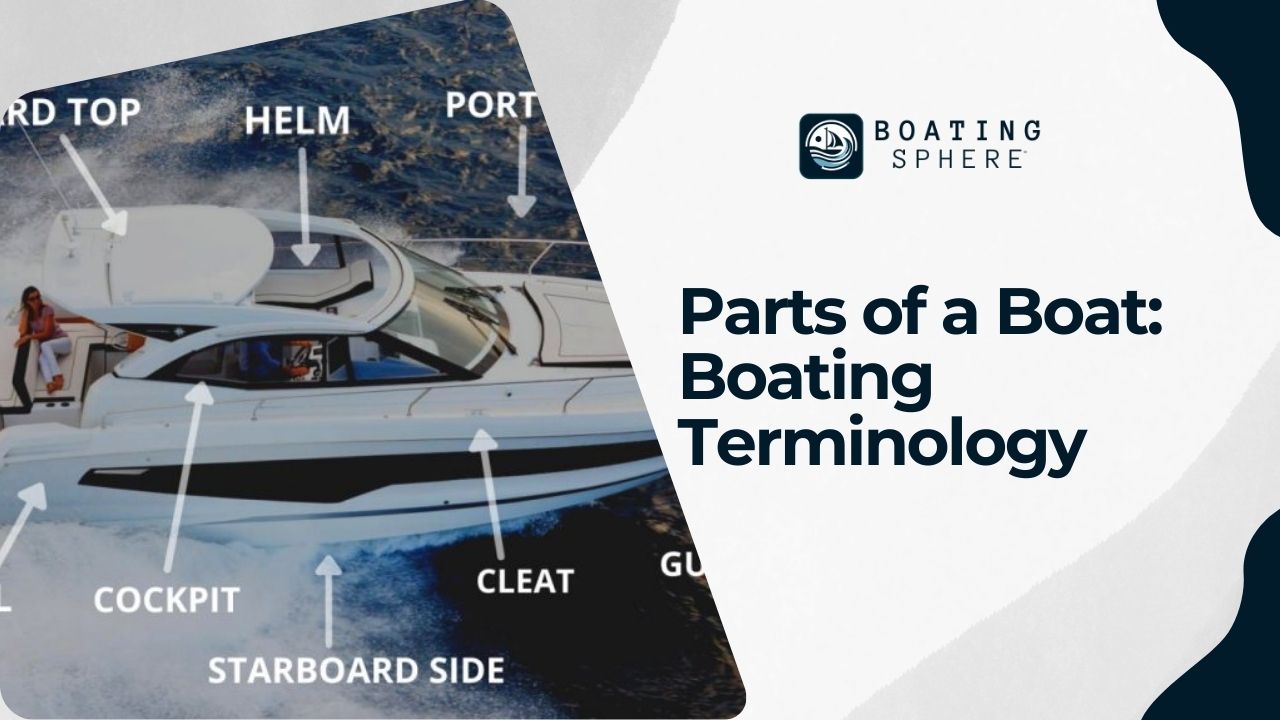Avid boaters should familiarize themselves with special terms and unique parts of a boat unavailable elsewhere. For instance, boating terminology includes distinctive names for the boat’s front, rear, kitchen, and bathroom areas. This introduction covers essential nautical terms related to boat parts.
Boating Terminology: 30 Important Part Names

- Ballast: Heavy materials, such as water, metal, or stone, positioned low in the boat’s hull, enhance its stability and sailing performance.
- Berth: Refers to a boat’s sleeping area or a docking spot where the ship is moored.
- Bilge: The boat hull’s lowest interior part, often collecting water.
- Bimini: A protective top made of canvas or hard material, shielding from sunlight and rain.
- Bow: The boat’s front section. Multihulls might have multiple bows.
- Bulkhead: A vertical wall inside the hull, providing structural support or dividing the living areas.
- Cabin: A boat’s interior living space, either as a whole or a specific sleeping area.
- Casting deck/platform: An elevated area at the front or rear of the boat designed for unobstructed fishing and improved water visibility.
- Cleat: A fixture made of wood, plastic, or metal, used to secure ropes, found on boats and docks.
- Cockpit: A semi-enclosed area on deck from where the boat is navigated or controlled.
- Console: A deck structure housing the helm or control station, possibly containing a toilet or storage below.
- Deck: The boat’s exterior has a flat surface.
- Dinette: The dinette is a dining area within the boat with tables and seats.
- Flybridge: The cabin’s top area typically hosts a control station and occasionally a lounge area.
- Galley: The boat kitchen area is located inside or on the deck.
- Gunwale: The upper edge of the boat’s hull side, marking the deck’s boundary.
- Hardtop: A roof-like structure over the cabin or console, offering elemental protection.
- Hatch: A deck or cabin opening as a window or door.
- Helm: The control station features steering mechanisms and engine controls.
- Hull: The boat’s main body or shell.
- Livewell: A tank that keeps fish or baits alive during fishing trips.
- Propeller: A blade-equipped rotating device propelling the boat through water.
- Rigging: The setup of wires, cables, or lines supporting the boat’s mast.
- Rudder: A steering device located below the waterline.
- Saloon: An interior communal area on a boat akin to a living room.
- Stern: The boat’s rear section.
- Swim platform: An aft-mounted structure facilitating easy water or dock access.
- T-top: A-frame supporting a canvas or hardtop, offering shade for the driver.
- Transom: The boat’s rear, linking the hull sides above the bottom.
- V-berth: A V-shaped bed at the boat’s bow, adapted to the area’s pointed shape.
This guide aims to equip newcomers with a foundational understanding of boating vocabulary, focusing on the parts of a boat.
General Nautical and Sailing Terms to Know

For those new to sailing or contemplating owning a sailboat, understanding these essential sailing and nautical terms is crucial for mastering the basics.
Aft
The ship’s rear section is the aft, also known as the stern. Anything located at the ship’s back is described as being aft.
Bow
The front part of the ship is called the bow. Knowing the bow’s location is crucial for identifying two other crucial sailing terms: port (left) and starboard (right of the bow).
Port
When facing the bow, the left-hand side of the boat is the port. The terms “left” and “right” can be confusing at sea, so “port” specifies the boat’s left side relative to its bow.
Starboard
When facing the bow, the boat’s right side is the starboard. To avoid confusion at sea, “starboard” specifies the boat’s right side relative to the bow.
Leeward
The leeward, also called downwind, points in the opposite direction to the direction the wind is blowing and is the counterpart of the upwind.
Windward
Windward denotes the direction the wind is blowing towards, opposite to leeward. Sailboats typically navigate with the wind, making windward a significant term in sailing.
Boom
The boom is a horizontal pole extending from the base of the mast. It is used to capture wind power for movement. Adjusting the boom towards the wind’s direction propels the sailboat.
Rudder
Situated below the boat, the rudder is a flat piece of wood, fiberglass, or metal. It is essential for steering. Larger sailboats use a wheel for rudder control, whereas smaller ones might have a direct steering mechanism aft.
Tacking
Tacking, the antithesis of jibing, involves turning the boat’s bow through the wind to switch the wind’s direction from one side of the ship to the other. The boom shifts sides during both a tack and a jibe.
Jibing
Contrary to tacking, jibing entails turning the boat’s stern through the wind, causing the wind to shift sides. This maneuver, less common than tacking, requires directing the ship directly into the wind, with the boom moving from one side to the other.
Grasping these terms lays a solid foundation for navigating the sailing world or making informed decisions about sailboat ownership.
Last Words
In summary, mastering boating terminology is crucial for anyone interested in boating, whether as a leisure activity or more seriously. It ensures clear communication among sailors and a comprehensive understanding of the boat’s components and their respective roles. Furthermore, familiarity with these terms significantly contributes to safety and minimizes the likelihood of mishaps at sea.
Thus, for experienced sailors and novices alike, learning these boating terms can greatly enrich the boating experience, making it more enjoyable and fulfilling.
Was this page helpful?

